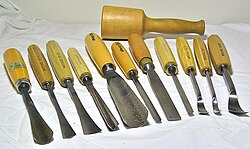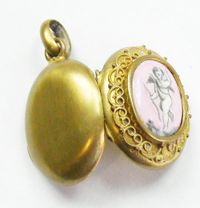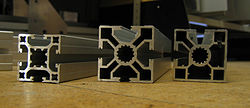Alloy
From DT Online
Very few metals in everyday use are in pure form (i.e. just the metallic element itself). In most cases, the metallic element has been mixed with another to improve a particular property or characteristic (e.g. Strength, Durability), to change its melting point or to improve how well it machines.
This process of mixing different metals together, or with other elements, to create a new material with particular properties and characteristics is known as Alloying and the resulting material is an Alloy.
Common Alloys
Ferrous Alloys
- Small amounts of Carbon produce a range of Steels and thus, Steel can be seen to be an Alloy of Iron and Carbon.
- Mild Steel (aka Low Carbon and Medium Carbon Steel) has a Carbon content of less than around 0.5%. This is not enough to enable to be Hardened and Tempered but it has sufficient Strength, Malleability and Ductility for most common purposes.
- Tool Steel has a Carbon content of between 0.5% and 1.5%. This amount of Carbon can only be held in solution with Iron at a high temperature which, if cooled or quenched suddenly, is ‘frozen’ in solution to create material too Hard and Brittle for most purposes. The process of Tempering allows some Carbon to diffuse out and controls the balance between Hardness and Toughness to make products ranging from wood chisels to clock springs.
- The addition of Chromium to steel produces Stainless Steel which has many applications where high strength and resistance to corrosion is required. The once commonly seen grade 18/8 Stainless Steel (now known as 403 grade), used for utensils, cutlery and cookware commonly found in kitchens everywhere, indicates that the steel contains 18% Chromium for greater strength and 8% nickel to improve its sheen or polish.
Copper-based Alloys
- Brass is an Alloy of Copper and Zinc the proportions of which can be varied to create either a hard brass or a softer brass. Other elements may also be added to enhance particular properties (e.g. the addition of Lead can make it easier to machine and adding Tin helps to stop the Zinc leaching out in marine environments).
- Brass is a decorative metal, it casts and machines well, it is a good bearing metal and resistant to corrosion. It is used to making plumbing fittings, ornaments, door furniture, gears, bearings, instruments and electrical switchgear for example.
- Gilding Metal is a type of Brass comprising 95% Copper and only 5% Zinc. These proportions give the Alloy a deeper, more golden, colour. It is used for decorative metalwork, goblets and plates (often silver-plated on completion), and as a low-cost training material for Silversmiths.
- Pinchbeck is a Brass in which the proportions of Copper and Zinc are chosen to result in a colour very close to Gold. Another 'Faux Gold' is Prince’s Metal which is also a Brass mixed to resemble Gold.
- Bronze is an Alloy of Copper with about 12% Tin. It is most commonly used for sculpture, coinage, some musical instruments and traditionally for ships' fittings, although this use is now largely superseded by Stainless Steel.
- Phosphor Bronze has 0.01-0.35% Phosphorus which increases wear resistance and stiffness of the Alloy. It has a low coefficient of friction making it a good material for bearings. It casts well and is used also to make ships' propellers.
- Gunmetal is a Bronze used originally to make guns. It casts well and is used to make valves and fittings for steam and hydraulics.
Solders
- Solders are Alloys used to join metals together. They are chosen to have a lower melting point than the metals to be joined so that, when heated, they can flow into the joint (and be ‘drawn’ into tight joints by Capillary Action). Solders are often also a Eutectic Alloy which means the proportions of the contributing elements are such that the Alloy solidifies quickly and at the lowest temperature.
- Ordinary Soft Solder, as used for making electrical connections, is an Alloy of approximately 60% Tin and 40% lead but Lead Free Solder is now available for use where there are Health and Safety concerns with regard to the Lead content.
- The once used Plumbers Solder had 50% Lead content which made it very useful for ‘wiping lead joints’ because it solidified slowly, giving time for the joint to be shaped, but Lead pipes are no longer used for plumbing because of the danger or Lead poisoning.
- Brazing Spelter is a Brass used as a filler rod when Brazing steels in particular.
- Hard Solders or Silver Solders are higher melting point Alloys most commonly of Copper with either Zinc or Silver. Higher quality Silver Solders contain sufficient Silver to ensure the finished product can still be Hallmarked.
- The proportions of the contributing elements are varied to create ‘Easy’, ‘Medium’ and ‘Hard’ Silver Solders - terms which denote grades of solder designed to melt at different temperatures. This enables complex articles to be soldered together in sequence, starting with ‘Hard’ for example, without subsequent heating causing previously made joints to melt.
Aluminium Alloys
- Aluminium is the world's most abundant metal but difficult to extract. The ore is found in clay, Bauxite being the most common source (perhaps this is why the Martians first dug clay pits to build their machines in ‘War of the Worlds’ by H.G. Wells?).
- Pure Aluminium is lightweight, resistant to corrosion, Ductile, and Malleable but quite soft and low strength. Aluminium Alloys are designed to improve strength, casting and working properties, or to make the material heat-treatable.
White Metal
- White Metal is a classification covering a range of light-coloured Alloys. The term is used by antique dealers to describe a variety of tableware and other non-silver ornaments or novelties. It describes also any of several Lead-based or Tin-based alloys used for things like bearings and small Zinc-based Die Cast components for example.
- Type Metal is the Lead-based Alloy used to make hot metal type used in printing. (Note:The metal type was traditionally held in compartmented cases ready for selection and use with capitals placed above their small letter equivalents - hence ‘upper-case’ and ‘lower case’ letters!).
- Pewter may have been used as far back as the Bronze Age and became used extensively in the Middle Ages to produce tableware, holloware and plateware. Its use declined with the development of mass-produced ceramics and glass, which now largely replace it.
- Britannia Metal is a refined type of Pewter developed in the second half of the 18th century. It became widely used as the base metal for silver-plating following the invention of Electro-plating










